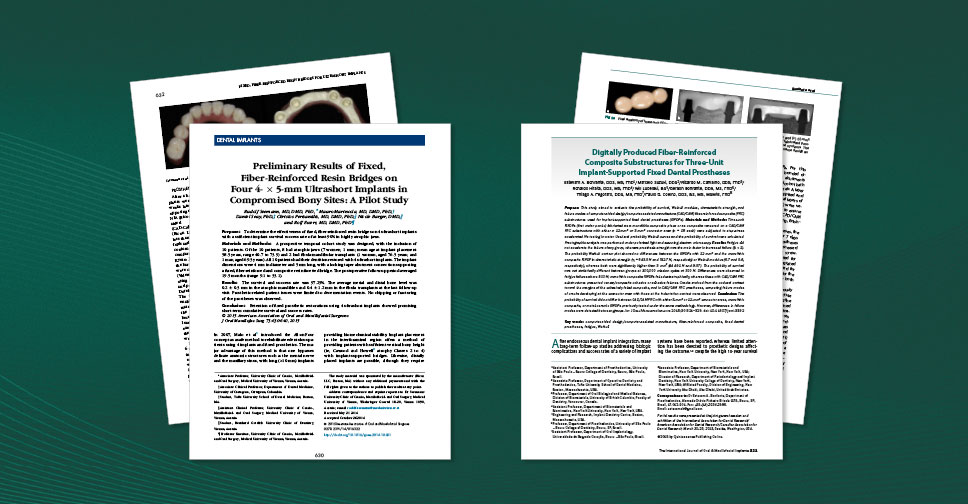Bicon is pleased to see the research community embracing the innovations of TRINIA™ and the Bicon Dental Implant System. We believe that disciplined research and scholarship is very important to our dental community as it increases knowledge about not only what works but why it works and helps provide more predictable outcomes for clinicians and their patients.

Seemann, R. Marincola, M., Seay, D., Perisanidis, C., Barger, N., Ewers, R., Preliminary Results of Fixed, Fiber-Reinforced Resin Bridges on Four 4- x 5-mm Ultrashort Implants in Compromised Bony Sites: A Pilot Study, Journal of Oral and Maxillofacial Surgery, April 2015, Vol.73, Issue 4, p.630-640.
Purpose
To determine the effectiveness of fixed, fiber-reinforced resin bridges on 4 ultrashort implants with a sufficient implant survival success rate of at least 90% in highly atrophic jaws.
Materials and Methods
A prospective temporal cohort study was designed, with the inclusion of 10 patients. Of the 10 patients, 8 had atrophic jaws (7 women, 1 man; mean age at implant placement 58.5 years, range 40.7 to 73.9) and 2 had fibula-mandibular transplants (1 woman, aged 76.5 years; and 1 man, aged 69.3 years). All 10 patients had their dentition restored with 4 ultrashort implants. The implant dimensions were 4 mm in diameter and 5 mm long, with a locking taper abutment connection supporting a fixed, fiber-reinforced and composite resin-facetted bridge. The postoperative follow-up period averaged 19.5 months (range 9.1 to 33.1).
Results
The survival and success rate was 97.25%. The average mesial and distal bone level was 0.2 ± 0.3 mm in the atrophic mandibles and 0.4 ± 1.2 mm in the fibula transplants at the last follow-up visit. Prosthetic-related patient issues were limited to decementation events. No chipping or fracturing of the prostheses was observed.
Conclusion
Retention of fixed prosthetic restorations using 4 ultrashort implants showed promising short-term cumulative survival and success rates.
Bonfante, E., Suzuki, M., Carvalho, R., Hirata, R., Lubelski, W., Bonfante, G., Pegoraro, T., Coelho, P., Digitally Produced Fiber-Reinforced Composite Substructures for Three-Unit Implant-Supported Fixed Dental Prostheses, The International Journal of Oral & Maxillofacial Implants , April 2015, p.321-329.
Purpose
This study aimed to evaluate the probability of survival, Weibull modulus, characteristic strength, and failure modes of computer-aided design/computer-assisted manufacture (CAD/CAM) fiber-reinforced composite (FRC) substructures used for implant-supported fixed dental prostheses (ISFDPs).
Materials and Methods
Three-unit ISFDPs (first molar pontic) fabricated as a monolithic composite piece or as composite veneered on a CAD/CAM FRC substructure with either a 12-mm2 or 3-mm2 connector area (n = 18 each) were subjected to step-stress accelerated life testing in water. Use-level probability Weibull curves and the probability of survival were calculated. Fractographic analysis was performed under polarized light and scanning electron microscopy.
Results
Fatigue did not accelerate the failure of any group, whereas prosthesis strength was the main factor in increased failure (β < 1). The probability Weibull contour plot showed no differences between the ISFDPs with 12 mm2 and the monolithic composite ISFDP in characteristic strength (η = 643.5 N and 742.7 N, respectively) or Weibull modulus (6.7 and 5.8, respectively), whereas both were significantly higher than 3 mm2 (444.91 N and 9.57). The probability of survival was not statistically different between groups at 100,000 mission cycles at 300 N. Differences were observed in fatigue failures above 800 N; monolithic composite ISFDPs failed catastrophically, whereas those with CAD/CAM FRC substructures presented veneer/composite cohesive or adhesive failures. Cracks evolved from the occlusal contact toward the margins of the cohesively failed composite, and in CAD/CAM FRC prostheses, competing failure modes of cracks developing at the connector area with those at the indentation contact were observed.
Conclusion
The probability of survival did not differ between CAD/CAM FRC with either 3-mm2 or 12-mm2 connector areas, monolithic composite, or metal-ceramic ISFDPs previously tested under the same methodology. However, differences in failure modes were detected between groups.